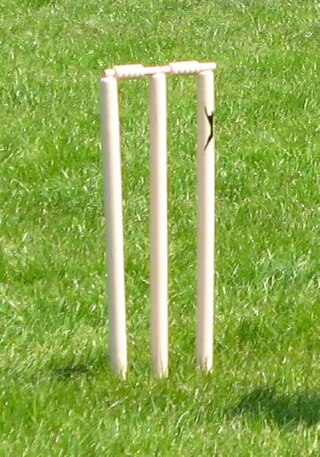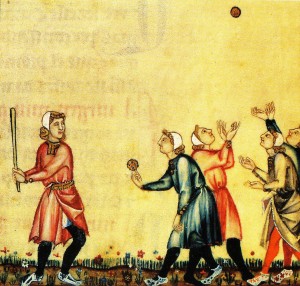Related Research Articles

Bowling, in cricket, is the action of propelling the ball toward the wicket defended by a batter. A player skilled at bowling is called a bowler; a bowler who is also a competent batter is known as an all-rounder. Bowling the ball is distinguished from throwing the ball by a strictly specified biomechanical definition, which restricts the angle of extension of the elbow. A single act of bowling the ball towards the batsman is called a ball or a delivery. Bowlers bowl deliveries in sets of six, called an over. Once a bowler has bowled an over, a teammate will bowl an over from the other end of the pitch. The Laws of Cricket govern how a ball must be bowled. If a ball is bowled illegally, an umpire will rule it a no-ball. If a ball is bowled too wide of the striker for the batsman to be able to play at it with a proper cricket shot, the bowler's end umpire will rule it a wide.

Rounders is a bat-and-ball game played between two teams. Rounders is a striking and fielding team game that involves hitting a small, hard, leather-cased ball with a wooden, plastic, or metal bat that has a rounded end. The players score by running around the four bases on the field.

Backyard cricket, also known as bat ball, street cricket, beach cricket, corridor cricket, garden cricket,gully cricket and box cricket, is an informal variant of cricket. It is typically played in various non-traditional venues such as gardens, backyards, streets, parks, carparks, beaches, and any area not specifically designed for the sport.
The Laws of Cricket is a code that specifies the rules of the game of cricket worldwide. The earliest known code was drafted in 1744. Since 1788, the code has been owned and maintained by the private Marylebone Cricket Club (MCC) in Lord's Cricket Ground, London. There are currently 42 Laws, which describe all aspects of how the game is to be played. MCC has re-coded the Laws six times, each with interim revisions that produce more than one edition. The most recent code, the seventh, was released in October 2017; its 3rd edition came into force on 1 October 2022.

The wicket-keeper in the sport of cricket is the player on the fielding side who stands behind the wicket or stumps being watchful of the batsman and ready to take a catch, stump the batsman out and run out a batsman when occasion arises. The wicket-keeper is the only member of the fielding side permitted to wear gloves and external leg guards. The role of the keeper is governed by Law 27 and of the Laws of Cricket.
In the game of cricket, the cricket pitch consists of the central strip of the cricket field between the wickets. It is 22 yd (20.12 m) long and 10 ft (3.05 m) wide. The surface is flat and is normally covered with extremely short grass, but can be completely dry or dusty soil with barely any grass or, in some circumstances, made from an artificial material. Over the course of a cricket match, the pitch is not repaired or altered other than in special circumstances - meaning that it will change condition. Any grass on the pitch in the game's first over, for example, may have disappeared by twentieth over due to wear.

In cricket, the term wicket has several meanings:

This is a general glossary of the terminology used in the sport of cricket. Where words in a sentence are also defined elsewhere in this article, they appear in italics. Certain aspects of cricket terminology are explained in more detail in cricket statistics and the naming of fielding positions is explained at fielding (cricket).

In cricket, an over consists of six legal deliveries bowled from one end of a cricket pitch to the player batting at the other end, almost always by a single bowler.

In cricket, a no-ball is a type of illegal delivery to a batter. It is also a type of extra, being the run awarded to the batting team as a consequence of the illegal delivery. For most cricket games, especially amateur, the definition of all forms of no-ball is from the MCC Laws of Cricket.

In cricket, batting is the act or skill of hitting the ball with a bat to score runs and prevent the loss of one's wicket. Any player who is currently batting is, since September 2021, officially referred to as a batter —regardless of whether batting is their particular area of expertise. Batters have to adapt to various conditions when playing on different cricket pitches, especially in different countries; therefore, as well as having outstanding physical batting skills, top-level batters will have quick reflexes, excellent decision-making skills, and be good strategists. Although batsman is still widely used.

In cricket, an extra is a run scored by, or awarded to, a batting team which is not credited to any individual batter. They are the runs scored by methods other than striking the ball with the bat.

In cricket, a dismissal occurs when a batter's innings is brought to an end by the opposing team. Other terms used are the batter being out, the batting side losing a wicket, and the fielding side taking a wicket. The ball becomes dead, and the dismissed batter must leave the field of play for the rest of their team's innings, to be replaced by a team-mate. A team's innings ends if ten of the eleven team members are dismissed. Players bat in pairs so, when only one batter remains who can be not out, it is not possible for the team to bat any longer. This is known as dismissing or bowling out the batting team, who are said to be all out.
Baseball and cricket are the best-known members of a family of related bat-and-ball games. Both have fields that are 400 feet (120 m) or more in diameter between their furthest endpoints, offensive players who can hit a thrown/"bowled" ball out of the field and run between safe areas to score runs (points) at the risk of being gotten out, and have a major game format lasting about 3 hours.
Obstructing the field is one of the nine methods of dismissing a batsman in the sport of cricket. Either batsman can be given out if he wilfully attempts to obstruct or distract the fielding side by word or action. It is Law 37 of the Laws of cricket, and is a rare way for a batsman to be dismissed; in the history of cricket, there has been only two instances in Test matches, nine in One Day International (ODI) matches, and six in Twenty20 International matches. There have also been seven instances in Test cricket, and two in ODIs, where a batsman has been dismissed handled the ball, a mode of dismissal now folded into obstructing the field.

A delivery or ball in cricket is a single action of bowling a cricket ball toward the batter. Once the ball has been delivered, batters may attempt to score runs, with the bowler and other fielders attempting to stop this by getting the batters out. When the ball becomes dead, the next delivery can begin.
In cricket, the batting order is the sequence in which batters play through their team's innings, there always being two batters taking part at any one time. All eleven players in a team are required to bat if the innings is completed.

Vigoro is a team sport, played mainly by women in Australia, that originally combined elements of cricket and tennis, although in its current form it may be more similar to cricket and baseball.

Bat-and-ball games are field games played by two opposing teams. Action starts when the defending team throws a ball at a dedicated player of the attacking team, who tries to hit it with a bat and run between various safe areas in the field to score runs (points). The defending team can use the ball in various ways against the attacking team's players to force them off the field when they are not in safe zones, and thus prevent them from further scoring. The best known modern bat-and-ball games are cricket and baseball, with common roots in the 18th-century games played in England.

Cricket is a bat-and-ball game played between two teams of eleven players on a field at the centre of which is a 22-yard (20-metre) pitch with a wicket at each end, each comprising two bails balanced on three stumps. Two players from the batting team stand in front of either wicket, with one player from the fielding team bowling the ball towards the striker's wicket from the opposite end of the pitch. The striker's goal is to hit the bowled ball and then switch places with the nonstriker, with the batting team scoring one run for each exchange. Runs are also scored when the ball reaches or crosses the boundary of the field or when the ball is bowled illegally.
References
- ↑ ""Wicket is a vanished game that for more than a century was the dominant game of parts of New England, notably Connecticut, and the Western Reserve, extending to Ohio and what is now termed the Midwest. Not baseball and not cricket, it may be understood as a primitive form of cricket, one no longer played in England by the middle of the 18th century."". Ourgame.mlblogs.com. 24 May 2017. Retrieved 15 March 2022.
- ↑ ""Wicket, or wicket ball, was a popular bat-and-ball game played by Americans in the years before baseball. Wicket lacks a definitive origin, though most historians of the game believe it developed from some early form of cricket imported to New England."". Ctexplored.org. 2 November 2018. Retrieved 15 March 2022.
- ↑ "Wethersfield's Glorious Baseball History". Wethersfieldhistory.org.
- ↑ ""On two occasions in May, 1778, soldiers stationed at Valley Forge recall playing wicket. The latter game involved George Washington himself, who played wicket with his men after dining with General Henry Knox."". Blog.litchfieldhistoricalsociety.org. p. 627. Retrieved 15 March 2022.
- ↑ ""But there are big differences between cricket and wicket, starting with the wicket itself. In the game of wicket, the wicket was long: six feet, and low, only inches above the ground, making it easy for the bowler or pitcher to knock the wicket off its stumps. But the wicket batsmen had an answer to the long exposed wicket: a big paddle-like bat that resembled an oversized spoon. Another big difference was the duration of the game. With as many as 30 people fielding the ball, and only three innings, a wicket game can wrap up in an afternoon, unlike cricket matches that can last for days."". Wnpr.org. 31 October 2013. Retrieved 15 March 2022.
- ↑ "Friends of Vintage Baseball". 3.238.31.98. Retrieved 15 March 2022.
- ↑ ""The "sham" was when a player dropped on his knees before the wicket and, failing to hit the ball, blocked it with his thighs. It wasn't an attitude that allowed hard hitting, but it tired out the best bowlers. This plan drove the opponents of the "sham" team to their wits' end [...] subsequently a new rule, "three shams out," broke up a practice which, if continued, would have wrecked the sport."". Ourgame.mlblogs.com. 27 August 2019. Retrieved 15 March 2022.